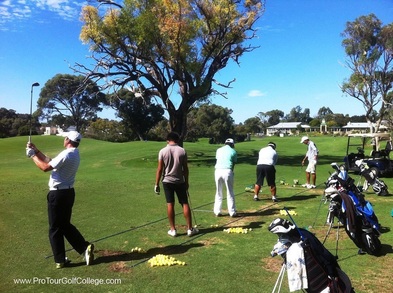 Students at Pro Tour Golf College follow a strict golf training routine everyday How would you like to practice so that there was a very high chance that you would significantly improve? It's been our experience at Pro Tour Golf College that the majority of golfers practicing and developing their game do not know how to practice correctly or effectively. In this article I’m going to explain how to practice your golf skills for continuous improvement. I’ll explain the key factors that influence behavioural change in golf practice and the common mistakes that golfers make when practicing their golf skills. I’ll also describe golf ‘best practice’ techniques that you can learn, adapt and introduce into your game to improve any aspect of your golf performance, whether on or off the golf course. So what is golf practice?... "Golf practice is the procedure you use for learning, developing and acquiring golf experience." We engage golf practice routines to develop, improve and master our golf skills and we do this by repeating a highly specific behaviour many times until we have a very high degree of competency and trust in it. 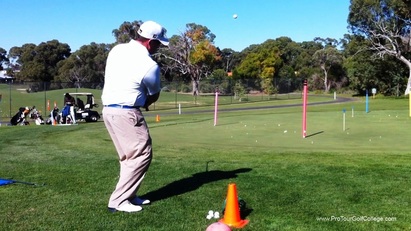 The students at PTGC train to lower competition golf scores which is the main objective. We do this to be able to perform a particular golf skill when it matters to us; for example hitting a high, soft pitch shot to a tightly tucked pin position on a severe down-hill slope would require a very specific golf stroke technique that travels on a very shallow and slightly outside to inside swing path to slice the ball from its lie. Golf practice therefore is simply the reinforcement of particular actions that help to create a specific type of result or set of results that we desire and by improving the nature of the way that you go about practicing your skills, you can in turn generate the results you seek sooner. Regrettably when we practice golf skills incorrectly we are setting ourselves up for failure. In other words when we really need to produce a result, this will be the time that the particular shot you’re attempting to play will more than likely not come off as planned. An example of practicing incorrectly would be to practice golf skills that you are already very competent at. Many golfers will go to the practice range with the same golf clubs and practice with them rather than practicing with clubs that they find more difficult to use and also golf shots they find difficult to play. 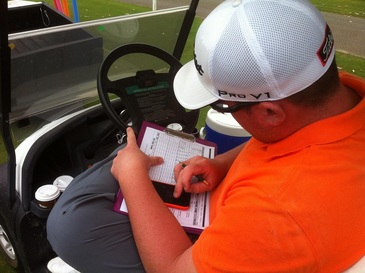 Students track, test and measure EVERY golf shot they hit everyday. Golf 'Best Practice' Golf ‘best practice’ (by Pro Tour Golf College) can be defined as; "The most efficient practice method that you can use that requires the least amount of effort and is the most effective way to achieve exceptional results in competition when performing the skill-set, based on repeatable well defined procedures that have proven themselves over time by a large numbers of golfers." Proven Practice Performance Platform So before you begin your practice session start by deciding on the best approach for improving your golf skills. The best way to go about this is to initiate a testing and measuring protocol to accurately assess the relative performance of your golf skills currently. Track and Measure If you were lost somewhere you would logically look for some point of reference to help you to determine where you are relative to where you want to be. Tracking and measuring your golf skills helps you to gain the necessary clarity you need to help you to know where your skills are at the present moment so you can determine where you wish to go with them. There is a relatively easy way to do this. Track a minimum of six rounds of golf and measure results in at least the following six categories. 1) What is your score average against par in competition? (Without using your handicap) 2) How many tee-shots do you hit into the fairway? 3) How many greens do you hit with your approach shot in regulation? (e.g. Hit a par 4 in two shots or a par 3 in one shot) 4) How many putts do you have for 18 holes on average? 5) How many bunker shots do you hit onto the green and achieve one putt? 6) How many chip and pitch shots do you hit onto the green and achieve one putt? Now of course you can measure many more categories with much greater detail if you like, and this will be dependent primarily on your golf skill ability. Low handicapped amateurs and professionals will measure many more categories with much greater detail to extract the information they need to develop a suitable plan for improvement. If you are an amateur golfer interested in becoming a top class amateur then the abovementioned categories are a good beginning for you. 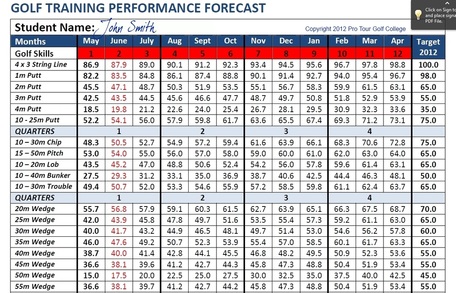 This is a sample of one of the training templates we use at PTGC Forecast and Estimate Forecasting the amount of improvement you desire and is essential for developing a planned approach to your golf improvement as well as fuelling your focus and desire to improve. Every successful golfer is motivated by performance goals and forecasting your future performances just helps you to stay on track with your improvement as well as helping you to determine how you should get there. Once you’ve tracked and measured the different skills that make-up a round of golf you need to estimate the amount of improvement you desire sometime in the future. If after six rounds you discovered that you hit thirty eight percent of fairways and that seventy percent of those tee-shots missed to the right, and you forecast that within six months you will hit at least forty eight percent of fairways or ten percent improvement in your tee-shot accuracy, your next step would be to decide what you need to do next. Isolate and Prescribe the Critical Elements Ok here’s where the rubber meets the road. Now you need to isolate the critical element in your technique that would help you to achieve better results. Of the categories you tested and measured, and using the driving accuracy example from earlier, what specifically will you do to improve your driving accuracy? Remember you’re looking for ten percent improvement over six months which equates to around one and half percent improvement per month. So you need to find a method for making the golf ball travel more down the target line so you can hit more fairways. You’ve isolated the problem that your tee-shots are travelling too often to the right of the fairway and now you need to prescribe a specific drill or training technique that will alter that situation and move you towards your ten percent improvement goal. This is where a series of lessons with a competent and experienced golf teaching professional would make good sense as you can isolate the problem in your golf swing technique faster so you can get on with the job of improving your tee-shot accuracy. Manage and Monitor The final step in the process is to determine how much work (effort) you will put into your golf practice to improve your performance by around 1.5 percent each month. You will need to manage your effort and also monitor your progress continually to ensure that you remain on track with your improvement. Managing your effort means to develop practice routines that incorporate the specific skills that you need to learn, modify or improve. When you practice your skills you will have to involve the following four practice dynamics in each practice session to influence how much improvement you will make each month. 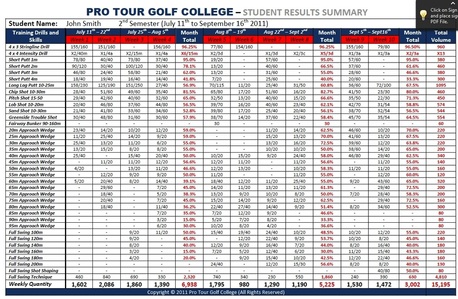 This is a sample of one of the training templates we use at PTGC Golf Training Volume: This is the exact amount of golf balls you will hit during each golf training session. Ideally you will break your practice volume into manageable sets of golf balls and hitting sets of ten or twenty golf shots per set makes it easy for you to stay focused, and it’s also easy to measure and manage. Golf Training Frequency: This is the rate of recurrence of practicing a particular skill. How often do you need to practice certain skills, and when is the best time to perform the skill? Should you practice putting after hitting three sets of driver shots – probably not? Managing the frequency of your practice helps you to manage energy expenditure and focus and is critical when developing an effective practice plan. Golf Training Duration: This is the period of time you actually invest in hitting your golf shots. The time it takes to hit sets of golf shots will vary depending on whether you’re practicing using a pre-shot routine or not. Technique practice doesn’t usually require that you use a pre-shot routine where practicing targeting skills does. So practice duration helps you to manage the different skills you will practice and fit them into your total plan. If you know that it takes you four minutes and thirty seconds to hit ten pitch shots to a target then you can easily work out how long it will take to hit ten sets of ten pitch shots to a target which will help you to plan your practice program more carefully and effectively. Golf Training Intensity: This is the level of focus or concentration you involve in your practice in practicing each skill. When you break your practice volume down into sets of ten golf shots and you practice the right skills at the best time, and you have worked out how many sets of shots you need to hit you will find it easier to focus on your skills and get the most out of yourself. Focus varies depending on the importance of the practice routine however by practicing correctly you give yourself the best opportunity to practice efficiently and effectively. When you practice a skill set the key is to control what you’re paying attention to. Your responsibility is to control your eye gaze and maintain it for each and every shot. Practicing your golf skills correctly means building a platform of strategies that support and enhance your effort to improve. It’s easy to just go out to the range and hit golf balls and hope that you will do something that makes you improve. It’s much more challenging to perform practice skills correctly by planning your strategy carefully and implementing it into your program so that the effort you put in actually leads to outcomes that you expect. Remember to always begin with the end in mind. Decide what you want to achieve from your golf game and notice where you are with it right now. Then go to work building a bridge from where you are to where you wish to go. Take your time, really think it through and in the days, weeks and months you’ll discover the other side of golf improvement. Lawrie and David - Pro Tour Golf College Comments are closed.
|
Archives
June 2019
|
Proudly Supported By
Copyright © 2011 - 2018 Pro Tour Golf College
Website Managed By Golf Performance Media
All Rights Reserved
Website Managed By Golf Performance Media
All Rights Reserved


 RSS Feed
RSS Feed



